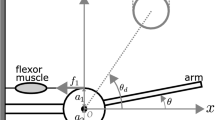Abstract
In this paper, we study trajectory planning and control in voluntary, human arm movements. When a hand is moved to a target, the central nervous system must select one specific trajectory among an infinite number of possible trajectories that lead to the target position. First, we discuss what criterion is adopted for trajectory determination. Several researchers measured the hand trajectories of skilled movements and found common invariant features. For example, when moving the hand between a pair of targets, subjects tended to generate roughly straight hand paths with bell-shaped speed profiles. On the basis of these observations and dynamic optimization theory, we propose a mathematical model which accounts for formation of hand trajectories. This model is formulated by defining an objective function, a measure of performance for any possible movement: square of the rate of change of torque integrated over the entire movement. That is, the objective function C T is defined as follows:
where z iis the torque generated by the i-th actuator (muslce) out of n actuators, and t fis the movement time. Since this objective function critically depends on the complex nonlinear dynamics of the musculoskeletal system, it is very difficult to determine the unique trajectory which yields the best performance. We overcome this difficult by developing an iterative scheme, with which the optimal trajectory and the associated motor command are simultaneously computed. To evaluate our model, human hand trajectories were experimentally measured under various behavioral situations. These results supported the idea that the human hand trajectory is planned and controlled in accordance with the minimum torquechange criterion.
Similar content being viewed by others
References
Abend W, Bizzi E, Morasso P (1982) Human arm trajectory formation. Brain 105:331–348
Atkeson CG, Hollerbach JM (1985) Kinematic features of unrestrained vertical arm movements. J Neurosci 5:2318–2330
Bizzi E, Accornero N, Chapple W, Hogan N (1984) Posture control and trajectory formation during arm movement. J Neurosci 4:2738–2744
Bryson AE, Ho YC (1975) Applied optimal control, Wiley, New York
Bullock D, Grossberg S (1988) Neural dynamics of planned arm movements: Emergent invariants and speed-accuracy properties during trajectory formation. Psychol Rev 95:49–90
Cannon SC, Zahalak GI (1982) The mechanical behavior of active human skeletal muscle in small oscillations. J Biomech 15:111–121
Flash T (1987) The control of hand equilibrium trajectories in multi-joint arm movements. Biol Cybern 57:257–274
Flash T, Hogan N (1985) The coordination of arm movements: An experimentally confirmed mathematical model. J. Neurosci 5:1688–1703
Hasan Z (1986) Optimized movement trajectories and joint stiffness in unperturbed, inertially loaded movements. Biol Cybern 53:373–382
Hogan N (1984) An organizing principle for a class of voluntary movements. J Neurosci 4:2745–2754
Hollerbach JM, Flash T (1982) Dynamic interactions between limb segments during planar arm movement. Biol Cybern 44:66–77
Hopfield JJ (1982) Neural networks and physical systems with emergent collective computational abilities. Proc Natl Acad Sci USA 79:2554–2558
Hopfield JJ, Tank DW (1985) “Neural” computation of decisions in optimization problems. Biol Cybern 52:141–152
Kawato M, Furukawa K, Suzuki R (1987) A hierarchical neuralnetwork model for control and learning of voluntary movement. Biol Cybern 57:169–185
Kawato M, Uno Y, Isobe M, Suzuki R (1988a) A hierarchical neural network model for voluntary movement with application to robotics. IEEE Control Sys Mag 8:8–16
Kawato M, Isobe M, Maeda Y, Suzuki R (1988b) Coordinates transformation and learning control for visually-guided voluntary movement with iteration: A Newton-like method in a function space. Biol Cybern 59:161–177
Koch C, Marroquin J, Yuille A (1986) Analog “neuronal” networks in early vision. Proc Natl Acad Sci USA 83:4263–4267
Marr D (1982) Vision. Freeman, New York
Mitsui T (1981) Newton method for the boundary-value problems of the differential equations (in Japanese). Math Sci 218:41–46
Morasso P (1981) Spatial control of arm movements. Exp Brain Res 42:223–227
Nelson WL (1983) Physical principles for economies of skilled movements. Biol Cybern 46:135–147
Ojika T, Kasue Y (1979) Initial-value adjusting method for the solution of nonlinear multipoint boundary-value problems. J Math Anal Appl 69:359–371
Poggio T, Torre V, Koch C (1985) Computational vision and regularization theory. Nature 317:314–319
Polite A, Bizzi E (1979) Characteristics of the motor programs underlying arm movements in monkeys. J Neurophysiol 42:183–194
Uno Y, Kawato M, Suzuki R (1987) Formation of optimum trajectory in control of arm movement — minimum torque- change model — Japan IEICE Technical Report, MBE86-79, 9–16
Author information
Authors and Affiliations
Rights and permissions
About this article
Cite this article
Uno, Y., Kawato, M. & Suzuki, R. Formation and control of optimal trajectory in human multijoint arm movement. Biol. Cybern. 61, 89–101 (1989). https://doi.org/10.1007/BF00204593
Received:
Issue Date:
DOI: https://doi.org/10.1007/BF00204593




